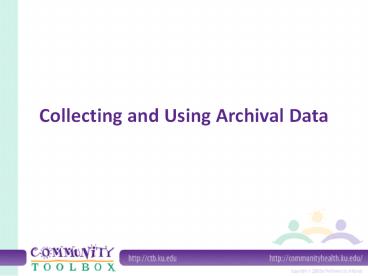Collecting and Using Archival Data - PowerPoint PPT Presentation
Title:
Collecting and Using Archival Data
Description:
Collecting and Using Archival Data What is archival data? Archival data is data that already exists in someone else s files as a result of administrative procedures ... – PowerPoint PPT presentation
Number of Views:80
Avg rating:3.0/5.0
Title: Collecting and Using Archival Data
1
Collecting and Using Archival Data
2
What is archival data?
- Archival data is data that already exists in
someone elses files as a result of
administrative procedures or past studies or
evaluations.
3
- Sources of Archival Data
- Public records
- Think tanks
- Health and human service organizations
- Schools and education departments
- Academic and similar institutions
- Business and industry
4
- Possible types of data available
- Demographics
- Behavior characteristics
- Health characteristics
- Attitudes racial, political, social, etc.
- Knowledge and awareness in certain areas
- Environmental conditions or factors affecting
the population and/or your work
5
- Why collect and use archival data?
- Its easier and less time-consuming than
collecting all the data yourself. - Archival data may have already been processed by
people with more statistical expertise than you,
making it easier to use in analysis. - Even with raw data, the basic organization and
preparation (transcription of interviews, entry
of numbers into a spreadsheet or specific
software, etc.) may have already been done, again
saving time and resources. - Its quite possible that you can find more
information than youd be able to gather if you
did it yourself.
6
- Archival data could touch on important areas you
might not have thought of, or identify patterns
or relationships you wouldnt have looked for. - It may eliminate the need to correct for such
problems as lack of inter-rater reliability or
observer bias. - Archival data allows the possibility of looking
at the effects of your work over time. - Archival data can make it possible for small
organizations with limited resources to
nonetheless conduct thorough evaluation studies.
7
- When should you collect and use archival data?
- When its available.
- When its relevant.
- When you dont have the time and/or resources to
collect the data yourself. - When it can truly inform your evaluation.
8
- How do you collect and use archival data?
- 1. Determine what information youre looking for
and why. - Data on past participants.
- General information on the population and/or the
community youre working with. - Specific information on appropriate
characteristics of the population youre working
with. - Cultural information.
- Data on a similar group that can be used as a
control or - comparison.
- Results of previous studies.
9
- Determine who is likely to have collected that
information. - Government departments and agencies, the census,
and other entities whose data is likely to be
available in public records. - Research organizations.
- Academia.
- News media.
- Foundations and other private funders.
- Hospitals and other health care providers.
- Mental health providers.
- Human service and other community-based
organizations. - Advocates and watchdog organizations.
10
- 3. Decide where you should look for archival
data. - Your own archives
- The Internet
- The original source
- Libraries
11
- 4. Decide how you plan to use the data once you
have it. - To better understand the context of your
evaluation. - To identify areas to address.
- To establish a baseline against which to measure
your results. - To identify already-existing trends that may
affect the results of your evaluation study. - To establish a standard of comparison against
which to measure your efforts. - To act as a control group.
- To provide data for a longitudinal study.































